horn HYUNDAI VELOSTER 2015 Owners Manual
[x] Cancel search | Manufacturer: HYUNDAI, Model Year: 2015, Model line: VELOSTER, Model: HYUNDAI VELOSTER 2015Pages: 384, PDF Size: 25 MB
Page 17 of 384
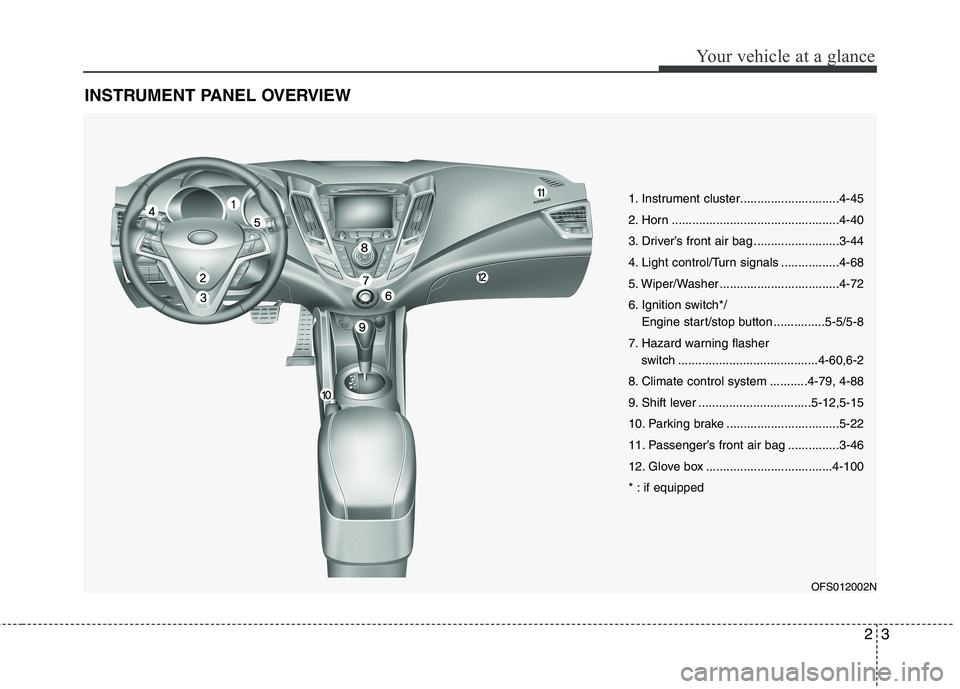
23
Your vehicle at a glance
INSTRUMENT PANEL OVERVIEW
OFS012002N
1. Instrument cluster.............................4-45
2. Horn .................................................4-40
3. Driver’s front air bag .........................3-44
4. Light control/Turn signals .................4-68
5. Wiper/Washer ...................................4-72
6. Ignition switch*/
Engine start/stop button ...............5-5/5-8
7. Hazard warning flasher
switch .........................................4-60,6-2
8. Climate control system ...........4-79, 4-88
9. Shift lever .................................5-12,5-15
10. Parking brake .................................5-22
11. Passenger’s front air bag ...............3-46
12. Glove box .....................................4-100
* : if equipped
Page 82 of 384
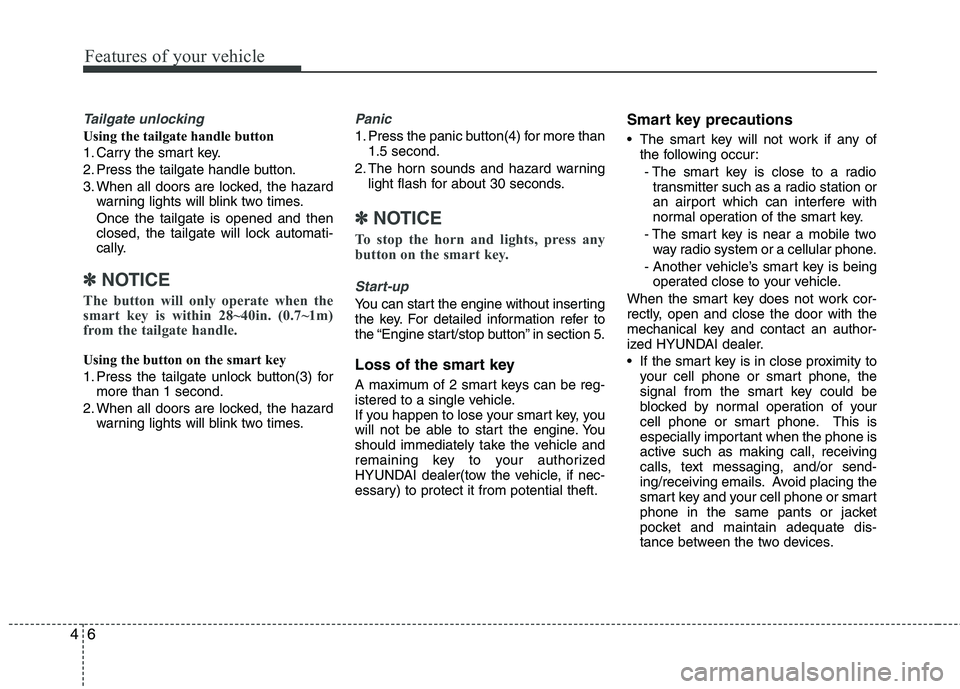
Features of your vehicle
6 4
Tailgate unlocking
Using the tailgate handle button
1. Carry the smart key.
2. Press the tailgate handle button.
3. When all doors are locked, the hazard
warning lights will blink two times.
Once the tailgate is opened and then
closed, the tailgate will lock automati-
cally.
✽ ✽
NOTICE
The button will only operate when the
smart key is within 28~40in. (0.7~1m)
from the tailgate handle.
Using the button on the smart key
1. Press the tailgate unlock button(3) for
more than 1 second.
2. When all doors are locked, the hazard
warning lights will blink two times.
Panic
1. Press the panic button(4) for more than
1.5 second.
2. The horn sounds and hazard warning
light flash for about 30 seconds.
✽ ✽
NOTICE
To stop the horn and lights, press any
button on the smart key.
Start-up
You can start the engine without inserting
the key. For detailed information refer to
the “Engine start/stop button” in section 5.
Loss of the smart key
A maximum of 2 smart keys can be reg-
istered to a single vehicle.
If you happen to lose your smart key, you
will not be able to start the engine. You
should immediately take the vehicle and
remaining key to your authorized
HYUNDAI dealer(tow the vehicle, if nec-
essary) to protect it from potential theft.
Smart key precautions
The smart key will not work if any of
the following occur:
- The smart key is close to a radio
transmitter such as a radio station or
an airport which can interfere with
normal operation of the smart key.
- The smart key is near a mobile two
way radio system or a cellular phone.
- Another vehicle’s smart key is being
operated close to your vehicle.
When the smart key does not work cor-
rectly, open and close the door with the
mechanical key and contact an author-
ized HYUNDAI dealer.
If the smart key is in close proximity to
your cell phone or smart phone, the
signal from the smart key could be
blocked by normal operation of your
cell phone or smart phone. This is
especially important when the phone is
active such as making call, receiving
calls, text messaging, and/or send-
ing/receiving emails. Avoid placing the
smart key and your cell phone or smart
phone in the same pants or jacket
pocket and maintain adequate dis-
tance between the two devices.
Page 86 of 384
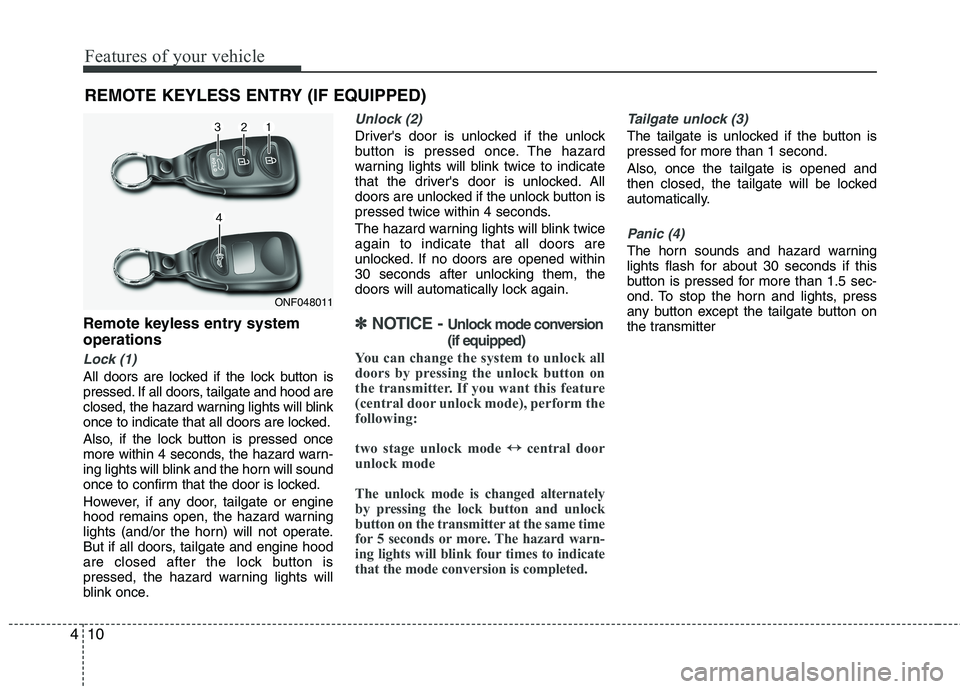
Features of your vehicle
10 4
Remote keyless entry system
operations
Lock (1)
All doors are locked if the lock button is
pressed. If all doors, tailgate and hood are
closed, the hazard warning lights will blink
once to indicate that all doors are locked.
Also, if the lock button is pressed once
more within 4 seconds, the hazard warn-
ing lights will blink and the horn will sound
once to confirm that the door is locked.
However, if any door, tailgate or engine
hood remains open, the hazard warning
lights (and/or the horn) will not operate.
But if all doors, tailgate and engine hood
are closed after the lock button is
pressed, the hazard warning lights will
blink once.
Unlock (2)
Driver's door is unlocked if the unlock
button is pressed once. The hazard
warning lights will blink twice to indicate
that the driver's door is unlocked. All
doors are unlocked if the unlock button is
pressed twice within 4 seconds.
The hazard warning lights will blink twice
again to indicate that all doors are
unlocked. If no doors are opened within
30 seconds after unlocking them, the
doors will automatically lock again.
✽ ✽
NOTICE - Unlock mode conversion
(if equipped)
You can change the system to unlock all
doors by pressing the unlock button on
the transmitter. If you want this feature
(central door unlock mode), perform the
following:
two stage unlock mode ↔ ↔
central door
unlock mode
The unlock mode is changed alternately
by pressing the lock button and unlock
button on the transmitter at the same time
for 5 seconds or more. The hazard warn-
ing lights will blink four times to indicate
that the mode conversion is completed.
Tailgate unlock (3)
The tailgate is unlocked if the button is
pressed for more than 1 second.
Also, once the tailgate is opened and
then closed, the tailgate will be locked
automatically.
Panic (4)
The horn sounds and hazard warning
lights flash for about 30 seconds if this
button is pressed for more than 1.5 sec-
ond. To stop the horn and lights, press
any button except the tailgate button on
the transmitter
REMOTE KEYLESS ENTRY (IF EQUIPPED)
ONF048011
Page 90 of 384
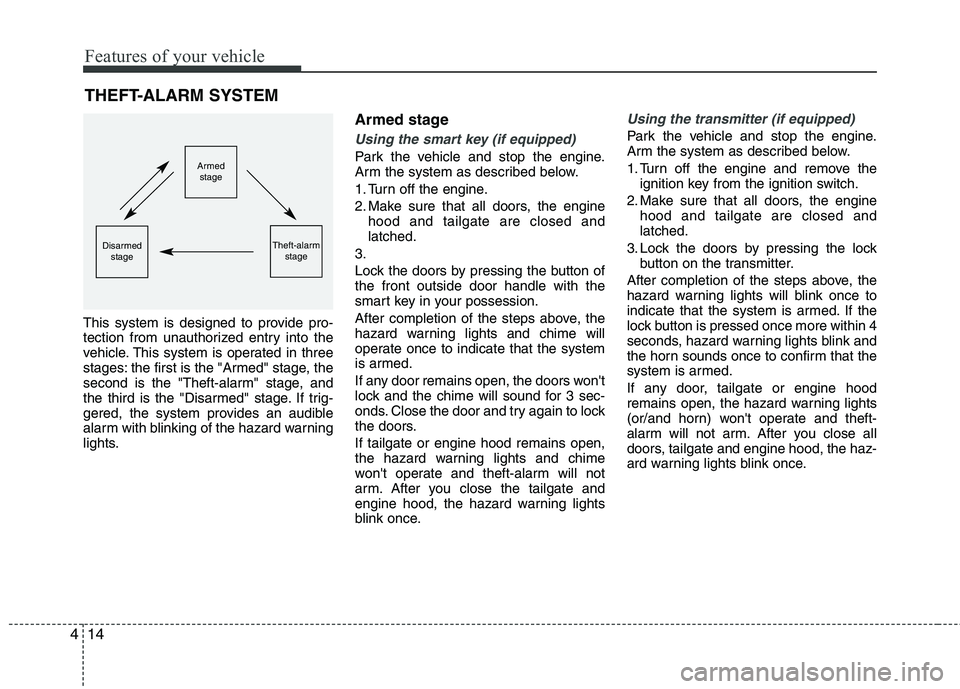
Features of your vehicle
14 4
THEFT-ALARM SYSTEM
This system is designed to provide pro-
tection from unauthorized entry into the
vehicle. This system is operated in three
stages: the first is the "Armed" stage, the
second is the "Theft-alarm" stage, and
the third is the "Disarmed" stage. If trig-
gered, the system provides an audible
alarm with blinking of the hazard warning
lights.
Armed stage
Using the smart key (if equipped)
Park the vehicle and stop the engine.
Arm the system as described below.
1. Turn off the engine.
2. Make sure that all doors, the engine
hood and tailgate are closed and
latched.
3.
Lock the doors by pressing the button of
the front outside door handle with the
smart key in your possession.
After completion of the steps above, the
hazard warning lights and chime will
operate once to indicate that the system
is armed.
If any door remains open, the doors won't
lock and the chime will sound for 3 sec-
onds. Close the door and try again to lock
the doors.
If tailgate or engine hood remains open,
the hazard warning lights and chime
won't operate and theft-alarm will not
arm. After you close the tailgate and
engine hood, the hazard warning lights
blink once.
Using the transmitter (if equipped)
Park the vehicle and stop the engine.
Arm the system as described below.
1. Turn off the engine and remove the
ignition key from the ignition switch.
2. Make sure that all doors, the engine
hood and tailgate are closed and
latched.
3. Lock the doors by pressing the lock
button on the transmitter.
After completion of the steps above, the
hazard warning lights will blink once to
indicate that the system is armed. If the
lock button is pressed once more within 4
seconds, hazard warning lights blink and
the horn sounds once to confirm that the
system is armed.
If any door, tailgate or engine hood
remains open, the hazard warning lights
(or/and horn) won't operate and theft-
alarm will not arm. After you close all
doors, tailgate and engine hood, the haz-
ard warning lights blink once.
Armed
stage
Theft-alarm
stageDisarmed
stage
Page 91 of 384

415
Features of your vehicle
Using the mechanical key
Park the vehicle and stop the engine.
Arm the system as described below.
1. Turn off the engine and remove the key
from the ignition switch(if equipped).
2. Make sure that all doors, the engine
hood and tailgate are closed and
latched.
3. Lock the doors by inserting the key into
the key hole on the front outside door
handle and turning the key toward the
front of the vehicle.
If any door, tailgate or engine hood
remains open, the theft-alarm will not
arm.
✽ ✽
NOTICE
If you lock or unlock the doors by using
the mechanical key, the hazard warning
light won't operate.
Do not arm the system until all pas-
sengers have left the vehicle. If the
system is armed while a passenger(s)
remains in the vehicle, the alarm may
be activated when the remaining pas-
senger(s) leave the vehicle. If any
door (or tailgate) or engine hood is
opened within 30 seconds after the
system enters the armed stage, the
system is disarmed to prevent an
unnecessary alarm.Theft-alarm stage
The alarm will be activated if any of the
following occurs while the system is
armed.
A door is opened without using the
transmitter (or smart key or mechani-
cal key).
The tailgate is opened without using
the transmitter (or smart key).
The engine hood is opened.
The horn will sound and the hazard
warning lights will blink continuously for
approximately 30 seconds. The alarm will
repeat once more unless the system is
disarmed. To turn off the system, unlock
the doors with the mechanical key or
transmitter or smart key.
Page 116 of 384
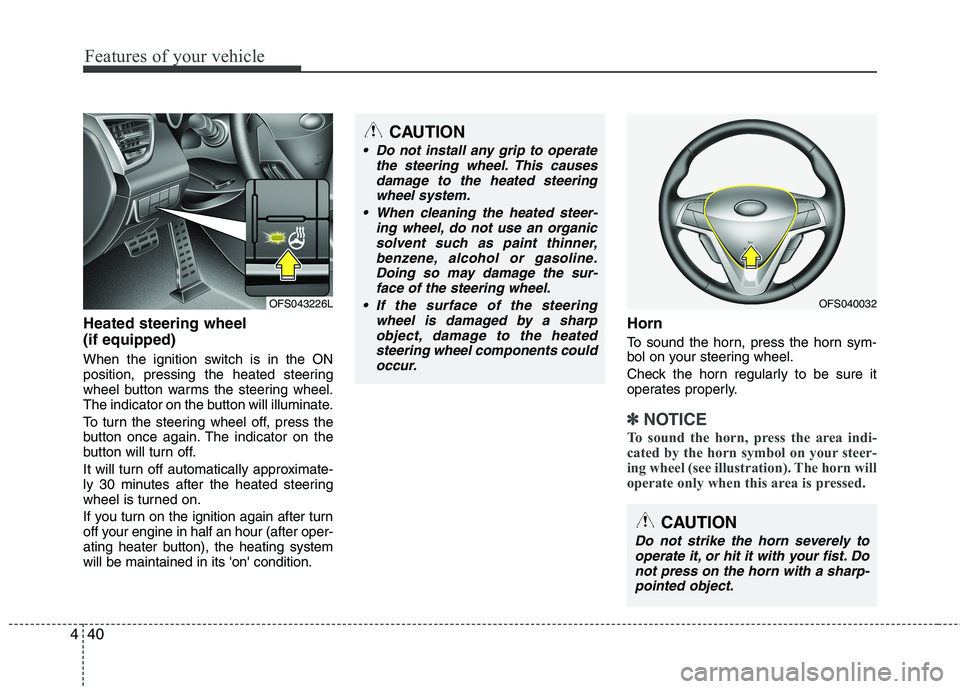
Features of your vehicle
40
4
Heated steering wheel
(if equipped)
When the ignition switch is in the ON
position, pressing the heated steering
wheel button warms the steering wheel.
The indicator on the button will illuminate.
To turn the steering wheel off, press the
button once again. The indicator on the
button will turn off.
It will turn off automatically approximate-
ly 30 minutes after the heated steering
wheel is turned on.
If you turn on the ignition again after turn
off your engine in half an hour (after oper-
ating heater button), the heating system
will be maintained in its 'on' condition.
Horn
To sound the horn, press the horn sym-
bol on your steering wheel.
Check the horn regularly to be sure it
operates properly.
✽ ✽
NOTICE
To sound the horn, press the area indi-
cated by the horn symbol on your steer-
ing wheel (see illustration). The horn will
operate only when this area is pressed.
CAUTION
Do not strike the horn severely to
operate it, or hit it with your fist. Donot press on the horn with a sharp-pointed object.
OFS040032
OFS043226L
CAUTION
Do not install any grip to operate the steering wheel. This causesdamage to the heated steeringwheel system.
When cleaning the heated steer- ing wheel, do not use an organicsolvent such as paint thinner, benzene, alcohol or gasoline.Doing so may damage the sur-face of the steering wheel.
If the surface of the steering wheel is damaged by a sharpobject, damage to the heatedsteering wheel components couldoccur.
Page 140 of 384
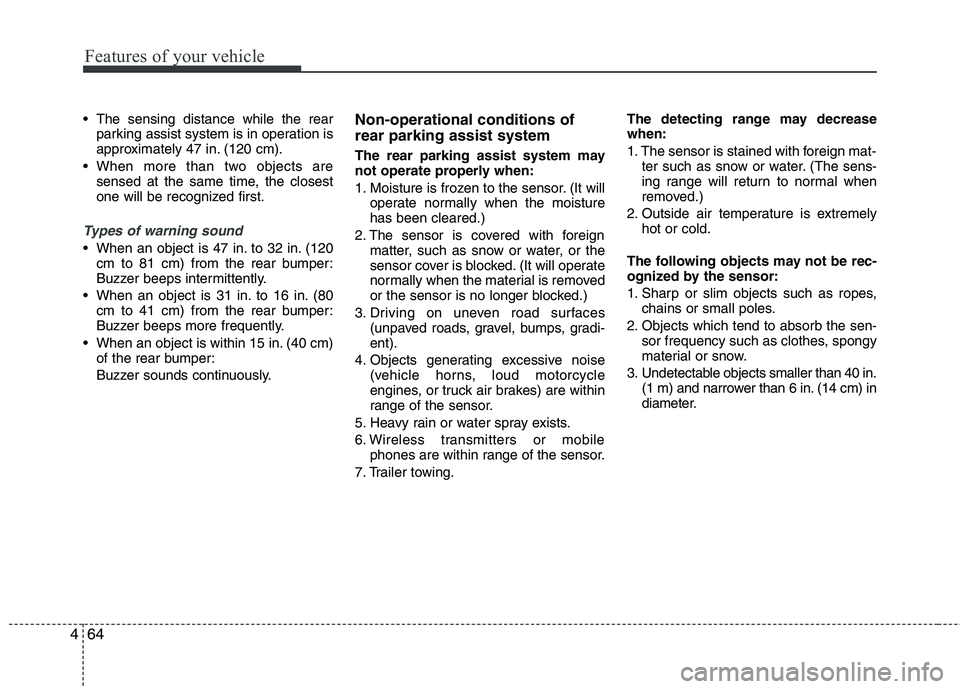
Features of your vehicle
64 4
The sensing distance while the rear
parking assist system is in operation is
approximately 47 in. (120 cm).
When more than two objects are
sensed at the same time, the closest
one will be recognized first.
Types of warning sound
When an object is 47 in. to 32 in. (120
cm to 81 cm) from the rear bumper:
Buzzer beeps intermittently.
When an object is 31 in. to 16 in. (80
cm to 41 cm) from the rear bumper:
Buzzer beeps more frequently.
When an object is within 15 in. (40 cm)
of the rear bumper:
Buzzer sounds continuously.
Non-operational conditions of
rear parking assist system
The rear parking assist system may
not operate properly when:
1. Moisture is frozen to the sensor. (It will
operate normally when the moisture
has been cleared.)
2. The sensor is covered with foreign
matter, such as snow or water, or the
sensor cover is blocked. (It will operate
normally when the material is removed
or the sensor is no longer blocked.)
3. Driving on uneven road surfaces
(unpaved roads, gravel, bumps, gradi-
ent).
4. Objects generating excessive noise
(vehicle horns, loud motorcycle
engines, or truck air brakes) are within
range of the sensor.
5. Heavy rain or water spray exists.
6. Wireless transmitters or mobile
phones are within range of the sensor.
7. Trailer towing.The detecting range may decrease
when:
1. The sensor is stained with foreign mat-
ter such as snow or water. (The sens-
ing range will return to normal when
removed.)
2. Outside air temperature is extremely
hot or cold.
The following objects may not be rec-
ognized by the sensor:
1. Sharp or slim objects such as ropes,
chains or small poles.
2. Objects which tend to absorb the sen-
sor frequency such as clothes, spongy
material or snow.
3. Undetectable objects smaller than 40 in.
(1 m) and narrower than 6 in. (14 cm) in
diameter.
Page 347 of 384
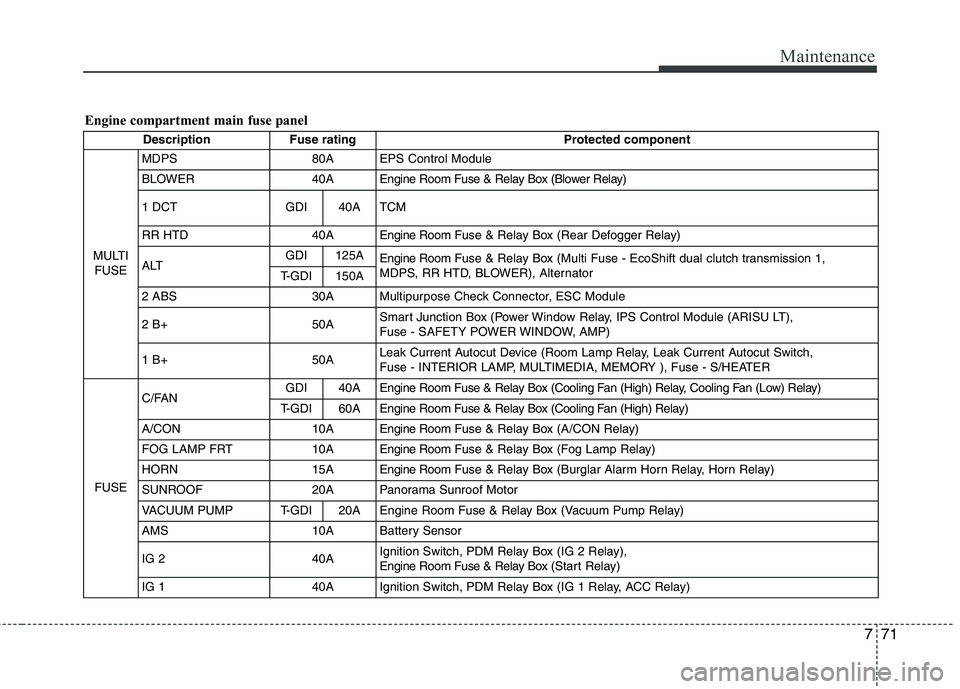
771
Maintenance
Engine compartment main fuse panel
Description Fuse rating Protected component
MULTI
FUSEMDPS 80A EPS Control Module
BLOWER 40A Engine Room Fuse & Relay Box (Blower Relay)
1 DCT GDI 40A TCM
RR HTD 40A Engine RoomFuse & Relay Box (Rear Defogger Relay)
ALTGDI 125A
Engine RoomFuse & Relay Box (Multi Fuse - EcoShift dual clutch transmission 1,
MDPS, RR HTD, BLOWER), Alternator
T-GDI 150A
2 ABS 30A Multipurpose Check Connector, ESC Module
2 B+ 50ASmart Junction Box (Power Window Relay, IPS Control Module (ARISU LT),
Fuse - SAFETY POWER WINDOW, AMP)
1 B+50ALeak Current Autocut Device (Room Lamp Relay, Leak Current Autocut Switch,
Fuse - INTERIOR LAMP, MULTIMEDIA, MEMORY ), Fuse - S/HEATER
FUSEC/FANGDI 40A Engine Room Fuse & Relay Box (Cooling Fan (High) Relay, Cooling Fan (Low) Relay)
T-GDI 60AEngine Room Fuse & Relay Box (Cooling Fan (High) Relay)
A/CON 10AEngine RoomFuse & Relay Box (A/CON Relay)
FOG LAMP FRT 10AEngine RoomFuse & Relay Box (Fog Lamp Relay)
HORN 15AEngine RoomFuse & Relay Box (Burglar Alarm Horn Relay, Horn Relay)
SUNROOF 20A Panorama Sunroof Motor
VACUUM PUMP T-GDI 20A Engine Room Fuse & Relay Box (Vacuum Pump Relay)
AMS 10A Battery Sensor
IG 2 40AIgnition Switch, PDM Relay Box (IG 2 Relay),
Engine Room Fuse & Relay Box (Start Relay)
IG 1 40A Ignition Switch, PDM Relay Box (IG 1 Relay, ACC Relay)
Page 380 of 384
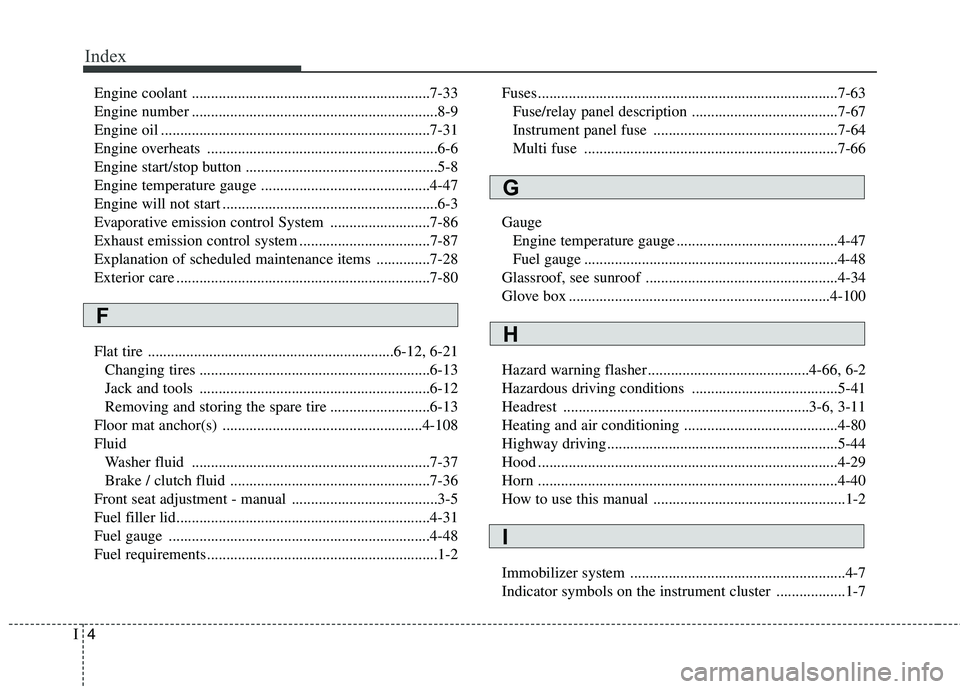
Index
4I
Engine coolant ..............................................................7-33
Engine number ................................................................8-9
Engine oil ......................................................................7-31
Engine overheats ............................................................6-6
Engine start/stop button ..................................................5-8
Engine temperature gauge ............................................4-47
Engine will not start ........................................................6-3
Evaporative emission control System ..........................7-86
Exhaust emission control system ..................................7-87
Explanation of scheduled maintenance items ..............7-28
Exterior care ..................................................................7-80
Flat tire ................................................................6-12, 6-21
Changing tires ............................................................6-13
Jack and tools ............................................................6-12
Removing and storing the spare tire ..........................6-13
Floor mat anchor(s) ....................................................4-108
Fluid
Washer fluid ..............................................................7-37
Brake / clutch fluid ....................................................7-36
Front seat adjustment - manual ......................................3-5
Fuel filler lid..................................................................4-31
Fuel gauge ....................................................................4-48
Fuel requirements ............................................................1-2Fuses ..............................................................................7-63
Fuse/relay panel description ......................................7-67
Instrument panel fuse ................................................7-64
Multi fuse ..................................................................7-66
Gauge
Engine temperature gauge ..........................................4-47
Fuel gauge ..................................................................4-48
Glassroof, see sunroof ..................................................4-34
Glove box ....................................................................4-100
Hazard warning flasher ..........................................4-66, 6-2
Hazardous driving conditions ......................................5-41
Headrest ................................................................3-6, 3-11
Heating and air conditioning ........................................4-80
Highway driving............................................................5-44
Hood ..............................................................................4-29
Horn ..............................................................................4-40
How to use this manual ..................................................1-2
Immobilizer system ........................................................4-7
Indicator symbols on the instrument cluster ..................1-7
F
G
H
I
Page 383 of 384
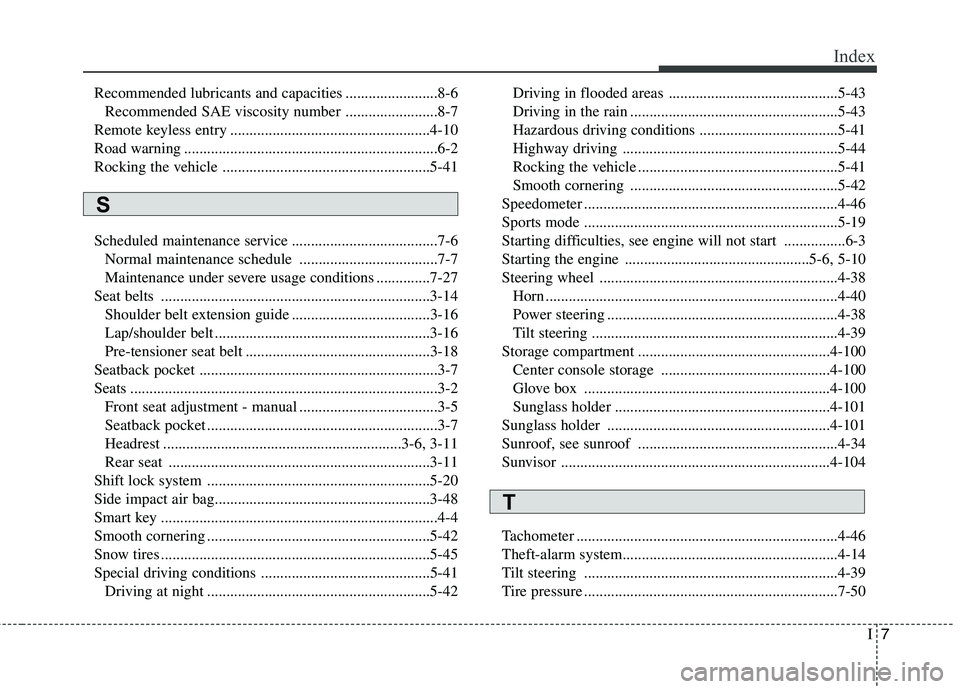
I7
Index
Recommended lubricants and capacities ........................8-6
Recommended SAE viscosity number ........................8-7
Remote keyless entry ....................................................4-10
Road warning ..................................................................6-2
Rocking the vehicle ......................................................5-41
Scheduled maintenance service ......................................7-6
Normal maintenance schedule ....................................7-7
Maintenance under severe usage conditions ..............7-27
Seat belts ......................................................................3-14
Shoulder belt extension guide ....................................3-16
Lap/shoulder belt ........................................................3-16
Pre-tensioner seat belt ................................................3-18
Seatback pocket ..............................................................3-7
Seats ................................................................................3-2
Front seat adjustment - manual ....................................3-5
Seatback pocket ............................................................3-7
Headrest ..............................................................3-6, 3-11
Rear seat ....................................................................3-11
Shift lock system ..........................................................5-20
Side impact air bag........................................................3-48
Smart key ........................................................................4-4
Smooth cornering ..........................................................5-42
Snow tires ......................................................................5-45
Special driving conditions ............................................5-41
Driving at night ..........................................................5-42Driving in flooded areas ............................................5-43
Driving in the rain ......................................................5-43
Hazardous driving conditions ....................................5-41
Highway driving ........................................................5-44
Rocking the vehicle ....................................................5-41
Smooth cornering ......................................................5-42
Speedometer ..................................................................4-46
Sports mode ..................................................................5-19
Starting difficulties, see engine will not start ................6-3
Starting the engine ................................................5-6, 5-10
Steering wheel ..............................................................4-38
Horn ............................................................................4-40
Power steering ............................................................4-38
Tilt steering ................................................................4-39
Storage compartment ..................................................4-100
Center console storage ............................................4-100
Glove box ................................................................4-100
Sunglass holder ........................................................4-101
Sunglass holder ..........................................................4-101
Sunroof, see sunroof ....................................................4-34
Sunvisor ......................................................................4-104
Tachometer ....................................................................4-46
Theft-alarm system........................................................4-14
Tilt steering ..................................................................4-39
Tire pressure ..................................................................7-50
S
T